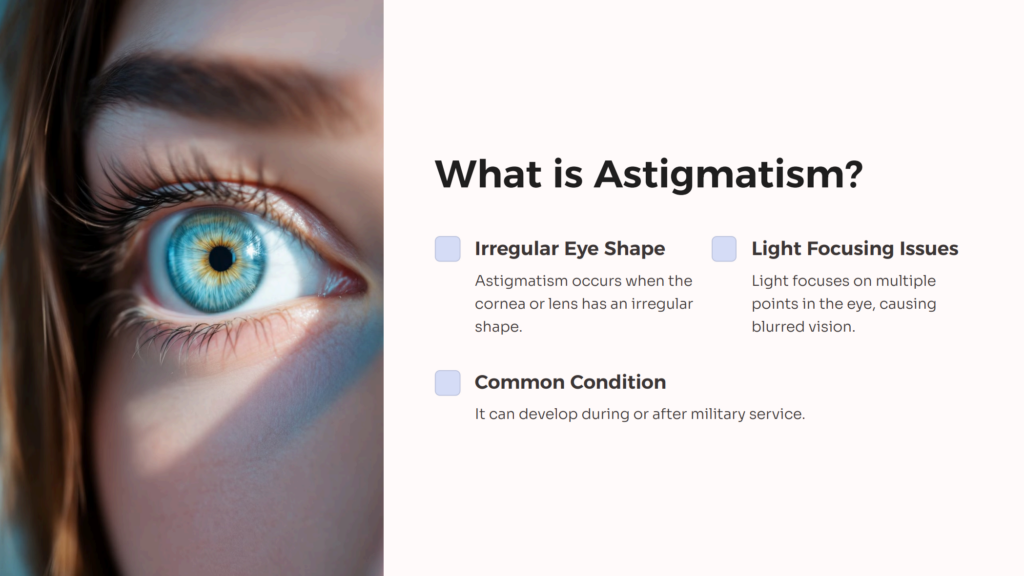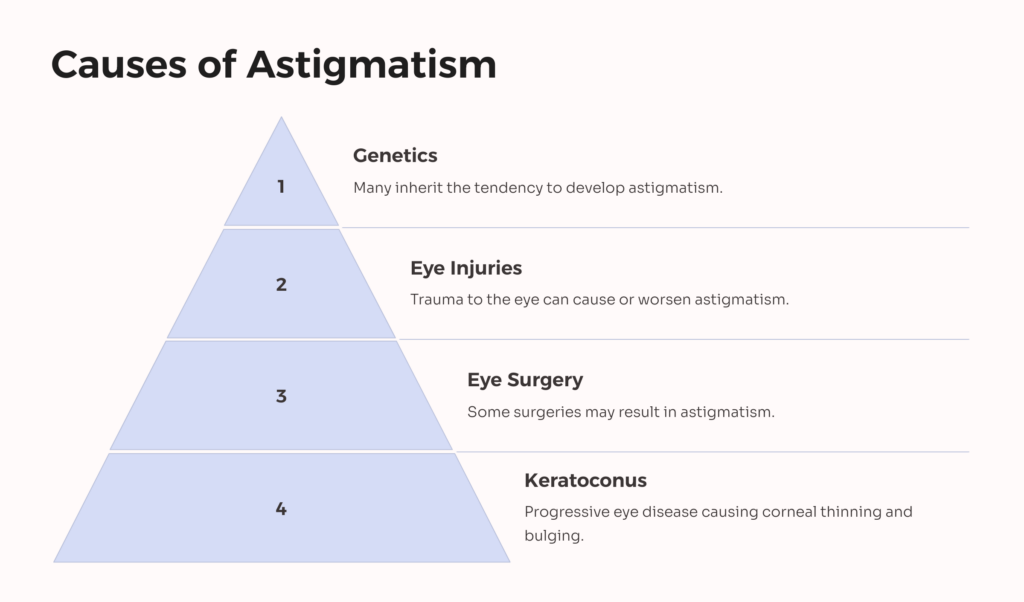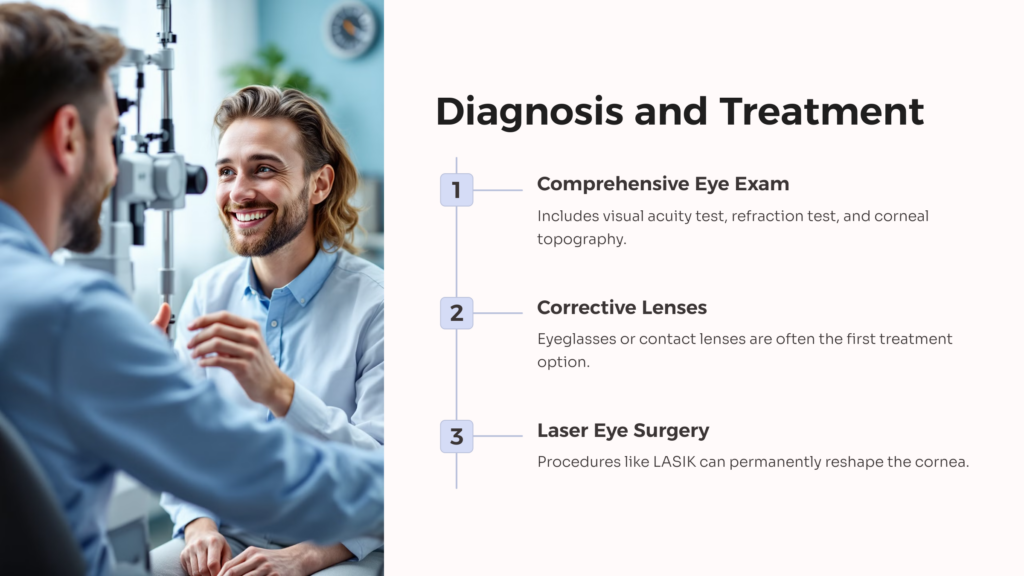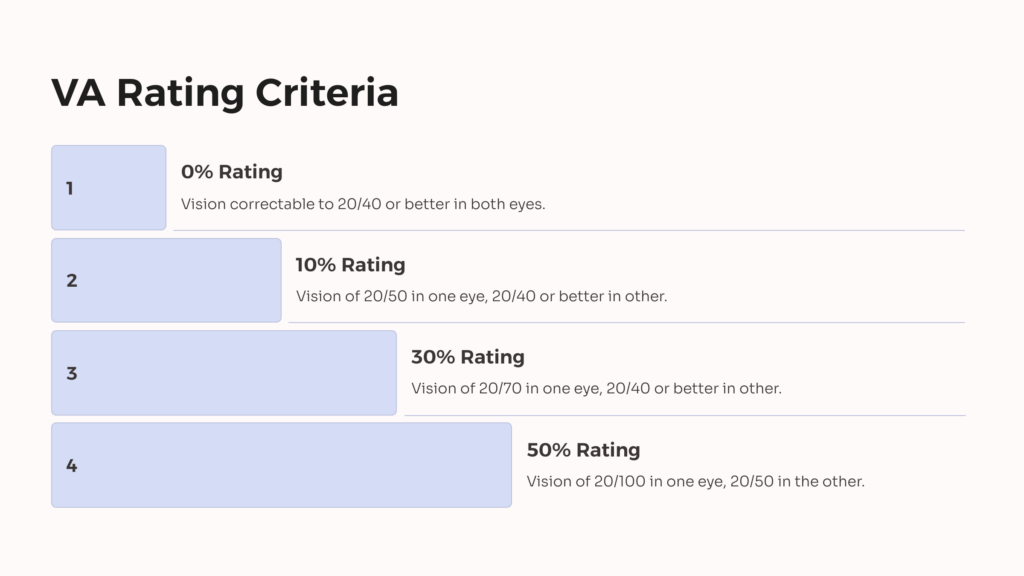
Astigmatism is a common eye condition that affects many veterans. It occurs when the cornea (the clear front part of the eye) or the lens inside the eye has an irregular shape. Instead of being perfectly round like a baseball, an eye with astigmatism is shaped more like a football. This irregular shape causes light to focus on multiple points in the eye rather than a single point, resulting in blurred or distorted vision.
For veterans, understanding astigmatism is crucial, especially when it comes to VA disability benefits. Astigmatism can develop during or after military service, and in some cases, it may be related to eye injuries or other service-connected conditions. While astigmatism is often considered a refractive error, which is typically not eligible for VA disability compensation, there are circumstances where it may qualify for benefits.
It’s important to note that astigmatism can occur alongside other eye conditions, such as nearsightedness (myopia) or farsightedness (hyperopia). When these conditions are combined, they can significantly impact a veteran’s vision and quality of life.
How Astigmatism Affects Vision
Astigmatism can affect vision in several ways, making daily activities challenging for veterans. The most common symptom is blurred or distorted vision at all distances, both near and far. This blurriness can lead to eye strain, headaches, and difficulty focusing on objects or text.
Veterans with astigmatism may find it hard to see fine details, especially in low-light conditions. They might squint or tilt their heads to try to see more clearly. Driving at night can be particularly problematic, as lights may appear to have a “halo” effect or cause glare. Reading, working on computers, or performing tasks that require visual precision can become tiring and uncomfortable.
For some veterans, astigmatism can also cause:
- Double vision
- Difficulty judging distances
- Poor depth perception
- Eyestrain and headaches after extended visual tasks
These symptoms can significantly impact a veteran’s daily life, work performance, and overall well-being. It’s crucial for veterans experiencing these issues to seek proper diagnosis and treatment, as well as explore their options for VA disability benefits if the condition is service-related.
Causes of Astigmatism

Astigmatism can have various causes, and understanding these is essential for veterans seeking VA disability benefits. While many people are born with astigmatism (congenital astigmatism), it can also develop later in life due to various factors, some of which may be related to military service.
Common causes of astigmatism include:
1. Genetics: Many people inherit the tendency to develop astigmatism from their parents.
2. Eye injuries: Trauma to the eye, which can occur during military service, may cause or worsen astigmatism.
3. Eye surgery: Certain eye surgeries, including those to correct other vision problems, can sometimes result in astigmatism.
4. Keratoconus: This progressive eye disease causes the cornea to thin and bulge into a cone-like shape, leading to significant astigmatism.
For veterans, it’s particularly important to consider service-related factors that might have caused or exacerbated astigmatism. These could include:
- Eye injuries from combat or training exercises
- Exposure to hazardous materials or extreme environmental conditions
- Complications from eye surgeries performed during military service
- Secondary effects of other service-connected conditions that impact eye health
If a veteran believes their astigmatism is related to their military service, it’s crucial to gather medical evidence and documentation to support their claim for VA disability benefits.
Diagnosing Astigmatism in Veterans

Proper diagnosis of astigmatism is crucial for veterans seeking VA disability benefits. The process typically involves a comprehensive eye examination conducted by an optometrist or ophthalmologist. These exams are often part of the VA’s Compensation and Pension (C&P) evaluation process.
During a typical eye exam for astigmatism, the doctor may perform several tests:
1. Visual acuity test: This measures how well you can see at various distances using an eye chart.
2. Refraction test: The doctor uses a device called a phoropter to measure your eye’s refractive error and determine the lens power needed to correct your vision.
3. Keratometry: This test measures the curvature of your cornea.
4. Corneal topography: A detailed map of your cornea’s surface is created to detect irregular shaping.
For veterans, it’s important to communicate any vision changes or eye-related issues experienced during or after military service. Be sure to mention any eye injuries, exposures to hazardous materials, or other relevant incidents from your service history.
The VA may also review your service medical records and post-service treatment history to establish a connection between your astigmatism and your military service. If you’re filing a VA claim for astigmatism, it’s beneficial to obtain a nexus letter from your eye care provider linking your condition to your military service.
Treatment Options for Astigmatism
Veterans diagnosed with astigmatism have several treatment options available, depending on the severity of their condition and personal preferences. Understanding these options is important for managing the condition and potentially influencing VA disability ratings.
Common treatments for astigmatism include:
1. Corrective lenses: Eyeglasses or contact lenses are often the first line of treatment. They can effectively correct vision in most cases of astigmatism.
2. Orthokeratology: This involves wearing rigid contact lenses at night to reshape the cornea temporarily. The effects can last throughout the day, allowing for clear vision without daytime corrective lenses.
3. Laser eye surgery: Procedures like LASIK (Laser-Assisted In Situ Keratomileusis) or PRK (Photorefractive Keratectomy) can reshape the cornea to correct astigmatism permanently.
4. Toric lens implants: For veterans with cataracts and astigmatism, special toric intraocular lenses can be implanted during cataract surgery to correct both conditions.
It’s important to note that while these treatments can improve vision, they don’t necessarily impact VA disability ratings unless they result in significant improvement or worsening of the condition. Veterans should discuss the best treatment options with their eye care provider and consider how these treatments might affect their VA benefits.
For veterans receiving VA health care, many of these treatments may be covered, especially if the astigmatism is service-connected. Always consult with your VA healthcare provider about available treatment options and coverage.
How to Qualify for VA Disability for Astigmatism
Qualifying for VA disability benefits for astigmatism can be challenging, as the VA typically considers it a refractive error, which is not usually eligible for compensation. However, there are circumstances where veterans may be able to receive benefits related to astigmatism.
To qualify for VA disability benefits for astigmatism, veterans generally need to meet the following criteria:
1. The astigmatism must be caused by or significantly worsened by military service.
2. The condition must result in a visual acuity of 20/40 or worse in one or both eyes, even with corrective lenses.
3. The astigmatism must be the result of a superimposed injury or disease that occurred during military service.
Veterans seeking to qualify for benefits should:
- Gather all relevant medical records, including those from service and post-service eye exams.
- Obtain a current diagnosis and assessment of visual acuity from an eye care professional.
- Collect statements from fellow service members or supervisors who can attest to any in-service incidents that may have caused or worsened the condition.
- Consider getting a nexus letter from a qualified medical professional linking the astigmatism to military service.
It’s important to note that while astigmatism itself may not qualify for benefits, any underlying eye conditions or injuries that caused the astigmatism might be eligible. Additionally, if astigmatism is secondary to another service-connected condition, it may be considered for benefits under secondary service connection.
Establishing Service Connection for Astigmatism
Establishing service connection for astigmatism is a critical step in securing VA disability benefits. While it can be challenging due to the VA’s stance on refractive errors, there are several avenues veterans can explore to connect their astigmatism to their military service.
To establish service connection, veterans need to prove that their astigmatism:
1. Was caused by an in-service event, injury, or illness
2. Was aggravated beyond its natural progression by military service
3. Is secondary to another service-connected condition
Here are some strategies for establishing service connection:
- Review your service medical records for any documented eye injuries or vision changes during service.
- Gather evidence of any hazardous conditions or exposures during service that could have affected your eye health.
- If your astigmatism developed after service, collect medical opinions linking its onset to your military experiences.
- For secondary service connection, obtain medical evidence showing how another service-connected condition led to or worsened your astigmatism.
It’s crucial to provide a clear timeline of your eye health before, during, and after military service. This can help demonstrate how your service impacted your vision. Remember, the burden of proof is on the veteran, so gathering comprehensive and compelling evidence is key to a successful claim.
If you’re struggling to establish service connection, consider seeking help from a Veterans Service Organization (VSO) or a VA-accredited claims agent. They can provide valuable guidance in navigating the claims process and building a strong case for service connection.
VA Rating Criteria for Eye Conditions

Understanding the VA rating criteria for eye conditions is crucial for veterans with astigmatism seeking disability benefits. While astigmatism itself doesn’t have a specific rating, it’s typically evaluated based on its impact on visual acuity and field of vision.
The VA uses the following criteria to rate eye conditions:
1. Central visual acuity
2. Visual field
3. Muscle function
For astigmatism and other refractive errors, the VA primarily considers central visual acuity. The rating schedule ranges from 0% to 100%, with higher ratings given for more severe vision impairment. Here’s a simplified breakdown:
- 0%: Vision correctable to 20/40 or better in both eyes
- 10%: Vision of 20/50 in one eye and 20/40 or better in the other
- 30%: Vision of 20/70 in one eye and 20/40 or better in the other
- 50%: Vision of 20/100 in one eye and 20/50 in the other
- 100%: Vision of 5/200 or worse in both eyes
It’s important to note that the VA rates based on corrected vision. This means they consider your visual acuity with glasses or contact lenses, not your uncorrected vision.
Additionally, if astigmatism is secondary to another service-connected condition, it may be rated differently. In such cases, the VA might consider the combined impact of all related eye conditions when assigning a rating.
Veterans should also be aware that the VA may consider other factors, such as pain, rest requirements, or incapacitating episodes related to eye conditions. These factors can influence the overall disability rating, even if visual acuity alone doesn’t warrant a high rating.
Understanding VA Compensation & Pension Exams
VA Compensation & Pension (C&P) exams play a crucial role in determining disability ratings for eye conditions, including astigmatism. These exams are conducted by VA-appointed healthcare providers to assess the severity and service connection of a veteran’s claimed conditions.
For eye conditions, a C&P exam typically includes:
1. A comprehensive eye examination
2. Visual acuity tests (both corrected and uncorrected)
3. Visual field testing
4. Assessment of eye muscle function
5. Evaluation of other eye-related symptoms or complications
During the exam, it’s important for veterans to:
- Provide a detailed history of their eye condition, including onset and progression
- Describe how the condition impacts daily activities and quality of life
- Mention any treatments received and their effectiveness
- Discuss any in-service events or exposures that may have caused or worsened the condition
The examiner will document their findings and provide an opinion on whether the eye condition is related to military service. This report is crucial in determining both service connection and disability rating.
Veterans should remember that C&P exams are not treatment appointments. The examiner’s role is to assess the condition, not provide care or offer treatment recommendations. It’s advisable to continue regular eye care with your primary eye care provider.
If you disagree with the results of a C&P exam, you have the right to request another examination or submit additional medical evidence to support your claim. Consider obtaining an independent medical opinion if you believe the C&P exam doesn’t accurately reflect your condition.
Secondary Conditions Related to Astigmatism
While astigmatism itself may not always qualify for VA disability benefits, it’s important for veterans to be aware of potential secondary conditions that could be related to their eye issues. These secondary conditions may be eligible for VA compensation, especially if they’re linked to a service-connected primary condition.
Some secondary conditions that may be associated with astigmatism or other eye disorders include:
1. Headaches: Chronic eye strain from astigmatism can lead to frequent headaches.
2. Neck pain: Constantly tilting or adjusting head position to see clearly can cause neck strain.
3. Mental health issues: Vision problems can contribute to anxiety or depression, particularly if they impact daily activities or job performance.
4. Balance problems: Severe astigmatism might affect depth perception, potentially leading to balance issues.
To claim these secondary conditions:
- Provide medical evidence linking the secondary condition to your eye problems
- Obtain a medical opinion stating that the secondary condition is “at least as likely as not” caused or aggravated by your eye condition
- Document how these secondary conditions impact your daily life and ability to work
It’s also worth noting that some eye conditions can be secondary to other service-connected disabilities. For example, certain autoimmune disorders, diabetes, or traumatic brain injuries can affect eye health and potentially cause or worsen astigmatism.
Veterans should discuss any symptoms or concerns with their healthcare providers, even if they seem unrelated to their eyes. A comprehensive approach to your health can help identify all potential service-connected conditions and ensure you receive appropriate compensation and care.
Navigating the VA Claims Process for Eye Conditions
Filing a VA claim for astigmatism or related eye conditions can be a complex process. Understanding the steps and requirements can help veterans navigate the system more effectively and increase their chances of a successful claim.
Here’s a step-by-step guide to filing a VA claim for eye conditions:
1. Gather evidence: Collect all relevant medical records, service records, and any documentation of in-service incidents that may have caused or worsened your eye condition.
2. Get a current diagnosis: Obtain a comprehensive eye exam from a qualified professional, documenting your current condition and its severity.
3. File your claim: Submit your claim online through the VA’s eBenefits portal, by mail, or in person at a VA regional office. Be sure to include all gathered evidence.
4. Attend C&P exam: If requested, attend the Compensation & Pension exam. Be honest and thorough in describing your condition and its impacts.
5. Wait for a decision: The VA will review your claim and send a decision letter. This process can take several months.
6. Appeal if necessary: If you disagree with the decision, you have the right to appeal. Consider seeking assistance from a VSO or attorney for the appeals process.
Tips for a successful claim:
- Be specific about how your eye condition affects your daily life and ability to work.
- If your astigmatism is secondary to another condition, clearly explain the connection.
- Consider obtaining a nexus letter from your doctor linking your condition to your military service.
- Keep copies of all submitted documents and correspondence with the VA.
Remember, the claims process can be lengthy and sometimes frustrating. Stay persistent, and don’t hesitate to seek help from veterans’ organizations or legal professionals specializing in VA claims if you encounter difficulties.
Frequently Asked Questions About VA Astigmatism Ratings
Veterans often have many questions about VA ratings for astigmatism and related eye conditions. Here are some frequently asked questions to help clarify common concerns:
1. Can I get VA disability for astigmatism? Astigmatism alone is typically considered a refractive error and not eligible for VA disability. However, if it’s caused by or worsened by a service-connected condition or injury, you may be eligible for benefits.
2. How does the VA rate eye conditions? The VA primarily rates eye conditions based on central visual acuity, visual field, and muscle function. Ratings range from 0% to 100% depending on the severity of vision impairment.
3. What if my astigmatism developed after service? If you can prove that your astigmatism is secondary to a service-connected condition or was caused by an in-service event, you may still be eligible for benefits.
4. Can I get VA disability for wearing glasses? Simply needing glasses doesn’t qualify for VA disability. The condition causing the need for glasses must be service-connected and meet certain severity criteria.
5. What if the VA denied my claim for astigmatism? You have the right to appeal the decision. Consider gathering additional evidence or seeking assistance from a VSO or attorney specializing in VA claims.
6. Does the VA cover treatment for astigmatism? If your astigmatism is service-connected, the VA may cover treatment. This can include corrective lenses or, in some cases, surgical procedures.
7. Can my astigmatism rating change over time? Yes, if your condition worsens, you can file for an increased rating. The VA may also schedule routine re-examinations to assess your condition.
Remember, every veteran’s situation is unique. Check us out at Allveteran.com and try our free medical evidence screening today to find out whether you’re eligible.
 AllVeteran.com Advisors
AllVeteran.com Advisors
With expertise spanning local, state, and federal benefit programs, our team is dedicated to guiding individuals towards the perfect program tailored to their unique circumstances.











